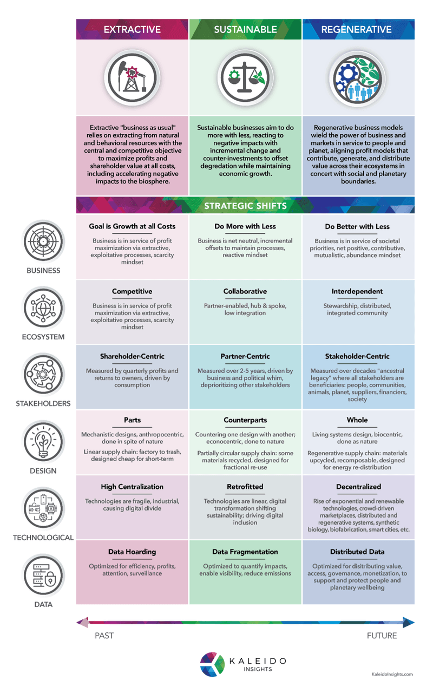This is how ESG can help your company save costs
Sustainability, CSR, ESG and especially regenerative business often sound very intimidating to business leaders.
.png)
Let’s face it, these are economically challenging times and many business leaders are focused on cutting costs in ways that will not harm their operations or customer and employee relations. That’s already a really hard challenge to pull off. While they are saving their business, saving the world isn’t exactly a priority for a lot of them.
But there are stages to sustainability. The thing with Big problems – who wouldn’t be intimidated by being asked to solve climate change – is that they always can be chopped up into smaller pieces. You tackle them step by step, and together with others. And the first stages are actually quite easy (well, you know…) and they make a really solid business case. That’s why I wanted to uncover the stages of ‘doing good’ in order to make ESG more appealing and less intimidating.
Stage 1: Optimization
Business leaders love efficiency. It’s what makes their system machinery well-oiled and has it functioning in the most optimal manners by cutting costs and accelerating processes. Of course, to cut costs you sometimes have to spend a little money, but most of us understand that.
Stage one of saving the planet, is about the optimization of energy and resources, which is coincidentally a great way to save a company as well. This is about investing in eco-efficiency, water management, waste management and energy efficiency in the short run to cut costs in the long term. HBIS Group for instance, one of the world’s largest steelmakers, uses industrial IoT to lower energy expenses as well as improve product quality, transparency and maintenance. Not a bad investment in times with very unstable energy prices.
Stage 2: Business model innovation
Innovation is crucial for the survival of companies. As the world evolves around them, so should their strategies, products and services. And the best way to build a business case for innovation is by solving an existing problem, of course. Luckily (yes, sometimes it’s allowed to be cynical) the current world has plenty of those to spare.
Orsted was once one of the most fossil fuel intensive companies in Europe. But they decided that the relevance of their business model was quickly declining because of regulation, their impact on climate change, customer behavior and the limits of earthly resources. So they made the seemingly bold but mostly completely rational move to completely reinvent themselves into a global green energy provider.
Stage 3: Enabling the ecosystem
The third stage of sustainability is when companies start to think beyond the borders of their companies. Stage 1 and 2 are still very company-centric. It’s about looking inside their own processes, product and services and increasing their efficiency and relevance. But the impact of one single company can only go so far. It only gets really interesting when a company makes changes inside its supply chain that impact its suppliers, local governments or even entire adjacent systems like healthcare.
An interesting example would be how a car company could remediate its own degenerative and declining business model by investigating the future of mobility in the smart city of the future, together with many other players. That is exactly what Toyota is doing in Japan with its Woven City concept, where it will analyze how a city should be designed, including in ways that cars would be used as little as possible. Another great example is Philips, which transformed itself from a consumer electronics giant into a health tech company. They want to improve the health and well-being of 2.5 billion people per year, including 400,000 people in medically underserved communities, by 2030. Such an ambitious goal cannot be achieved with single, standalone solutions. If you want to offer access to primary healthcare in countries where there is little of that, you need to fix the backbone of the system first. And so Philips is building community life centers for healthcare, providing electricity there and collaborating with all types of (local) institutions and governments in a shared value approach.
Stage 4: Regeneration
Now this is boss level sustainability. Well, actually, this is the stage beyond sustainability. Because the latter wants businesses to stop extracting and do more with less, while regenerative business is all about restoring, renewing and/or healing systems we depend on. It’s about giving back to the natural and social systems around us in order to make them better.

A regenerative product is for instance made from a material that is beneficial to the planet. Hemp would be a great example of a regenerative material because:
- it helps sequester carbon
- it can stimulate biodiversity, if it is grown in amore natural ecosystem (no monocropping)
- it is biodegradable at the end of its life
Probably no surprise that Patagonia is one of the pioneers of the regenerative approach to business. In fact, they helped to found the Regenerative Organic Certified program, which is a revolutionary certification for food, textiles and other personal care ingredients. The aim is to ensure that farm workers are fairly compensated, animal welfare is prioritized and soils are regenerated.
Sustainability and regeneration can be intimidating concepts, especially if you look at them from a short term cost perspective and bear in mind that you are part of an entire system that needs healing. I think that’s probably why a lot of companies freeze into inaction because the problems surrounding us seem too big to tackle alone. But what you do when that happens is 1. you take it step by step, stage by stage and 2. you get help and collaborate. This is how you’ll be able to save the world, and your company.




